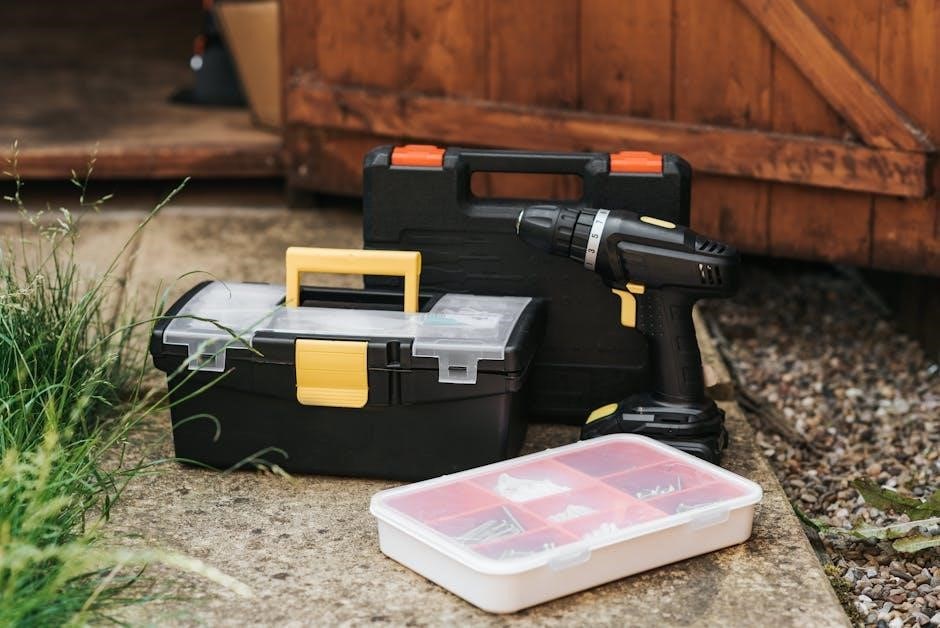The VEX High Stakes Manual serves as the official guide for the 2024-2025 competition, detailing rules, gameplay, and robot specifications to ensure fair and engaging matches.
Purpose of the Manual
The VEX High Stakes Manual is a comprehensive guide detailing the rules, scoring, and gameplay for the 2024-2025 competition. It serves as both a rulebook and an educational tool, fostering teamwork, perseverance, and problem-solving skills. Regular updates ensure clarity and fairness, providing all teams with a consistent understanding of the game’s objectives and regulations. Accessible to teams of all experience levels, this manual is essential for participants to excel in the competition.
Key Components of the High Stakes Game
The High Stakes game involves robots scoring points by placing rings on stakes, with a 12×12 field featuring mobile goals and wall stakes. Matches include a 30-second autonomous period and a 1:30 driver-controlled phase. Teams form alliances, combining their scores to achieve victory. The game emphasizes strategic robot design, precise autonomous programming, and efficient driver skills to maximize scoring opportunities during each match.
Game Rules and Gameplay
The High Stakes game involves a 12×12 field, 30-second autonomous period, and 1:30 driver-controlled phase. Alliances of two teams each score points by placing rings on stakes.
Scoring and Objectives
Teams earn points by scoring rings on stakes, with higher values for wall stakes and mobile goals. Each alliance aims to accumulate the most points by strategically placing rings and controlling field zones. Bonus points are awarded for parking robots in designated areas at the end of the match, adding a final strategic layer to the competition.

Autonomous and Driver-Controlled Periods

Matches begin with a 30-second Autonomous Period, where robots operate independently using pre-programmed instructions. This is followed by a 1-minute and 30-second Driver-Controlled Period, where drivers manually operate the robots. The transition between these periods is seamless, with scoring continuing uninterrupted. Both phases are critical for maximizing points and achieving team objectives.

Robot Specifications and Design
Robots must comply with size, weight, and component rules, ensuring safety and fair competition. Designs must pass inspections to meet technical and safety standards.
Robot Build Requirements
Robots must adhere to specific size and weight limits: maximum 18x18x18 inches and under 30 pounds. Materials like metal, plastic, and rubber are permitted; All robots must use VEX V5 components, including motors, sensors, and controllers. Additional parts, such as 3D-printed elements, are allowed if they meet safety and competition standards. Teams must ensure their robots comply with all technical specifications outlined in the manual to pass inspection and compete effectively.
Inspection and Compliance Standards
Robots undergo a thorough pre-match inspection to ensure compliance with safety and technical standards. All components must meet size, weight, and material requirements. Electrical and mechanical systems are checked for functionality and adherence to rules. Teams must use approved VEX V5 components exclusively. Inspection ensures fair competition and verifies robots meet all safety protocols before being allowed on the field. Compliance is non-negotiable for participation.

Tournament Structure and Rules
Tournaments consist of qualifying matches and elimination rounds. Teams form alliances, with rankings based on performance. Rules govern match formats, penalties, and fair play standards.
Match Formats and Alliances
Matches feature two alliances, each consisting of two teams (red and blue), competing to score points. The game includes a 30-second Autonomous Period and a 1:30 Driver-Controlled Period. Alliances earn points by scoring rings, climbing stakes, and completing tasks. Teams work collaboratively to maximize their collective score, with the highest-scoring alliance winning the match.
Penalties and Disqualifications
Penalties are imposed for rule violations, such as unsafe actions or field interference. Minor infractions incur point deductions, while severe offenses may lead to match disqualification. Disqualifications are issued for repeated or intentional disregard of rules, resulting in loss of match points. Teams must adhere to guidelines to avoid such outcomes and maintain fair competition.
Updates and Changes in the Manual
The VEX High Stakes Manual is regularly updated with rule clarifications and amendments. Version 3.0 includes new rules like S5 and updated sections like SC3b for clarity.

Release Dates and Version History
The VEX High Stakes Manual is updated periodically, with Version 3.0 released for the 2024-2025 season. Key updates include the addition of Rule S5 and modifications to SC3b for clarification. The manual is available in 25 languages, ensuring accessibility for global participants. Updates are announced via official VEX channels, with the latest version accessible at https://link.vex.com.
Rule Clarifications and Amendments
The VEX High Stakes Manual undergoes regular clarifications to ensure fair gameplay. Rule S5 was added, focusing on participant release forms, while SC3b was revised for clarity. The Game Design Committee (GDC) provides official interpretations through a Q&A system, addressing community inquiries and ensuring consistency. These updates are detailed in manual versions, with the latest changes reflected in Version 3.0 for the 2024-2025 season.
Field Setup and Configuration

The VEX High Stakes field is a 12×12 square, configured with mobile goals, wall stakes, and scoring zones. Assembly guides ensure accurate setup for competition consistency.
Field Overview and Dimensions
The VEX High Stakes field is a 12×12 square, designed to accommodate two alliances. It features mobile goals, wall stakes, and a perimeter for scoring. The field includes nine stakes—five on mobile goals and four on walls—along with 48 rings for scoring. Assembly instructions ensure consistent setup, while the field’s layout promotes strategic gameplay and balanced competition.
Assembly Instructions for Field Kits
The VEX High Stakes field kits include step-by-step guides for constructing the 12×12 competition area. Instructions cover assembling the perimeter, mobile goals, and wall stakes using components like aluminum framing and brackets. Tools such as Allen wrenches and screwdrivers are required. The downloadable PDFs ensure accurate setup, enabling teams to replicate the official field configuration for consistent gameplay and fair competition.
Robot Skills Challenge
The Robot Skills Challenge tests individual robot capabilities and driver skills, using all 24 red rings and 5 mobile goals. Detailed rules are in the manual.
Skills Challenge Rules and Scoring
The Robot Skills Challenge evaluates robot performance and driver proficiency. Teams score points by placing rings on stakes and mobile goals, with bonuses for specific achievements. The challenge uses 24 red rings and 5 mobile goals, starting in designated locations. Scores are based on ring placement and goal interactions. The highest score determines rankings, emphasizing precision and strategic gameplay.
Skills Challenge Field Setup
The Skills Challenge Field features 48 rings and 9 stakes, including 5 on mobile goals, 4 wall stakes, and 1 high stake. The field is 12×12 feet, with specific zones for scoring. Teams must navigate robots to score rings on stakes and interact with goals. Setup follows the VEX High Stakes Manual, ensuring consistency across competitions. Precision in field assembly is crucial for fair and accurate scoring.

Q&A and Rules Clarifications
The Q&A section provides official clarifications from the Game Design Committee (GDC), addressing common questions and interpretations of the VEX High Stakes Manual rules.

Official Clarifications from GDC
The Game Design Committee (GDC) issues official clarifications to address rule interpretations, ensuring consistency across all VEX High Stakes events. These updates are released periodically and are binding for all teams; Clarifications cover topics like robot interactions, scoring, and field elements, providing clear guidance to resolve disputes and maintain fair competition. Teams must stay updated to comply with the latest rulings and adjustments.
Common Questions and Solutions
Frequently asked questions about the VEX High Stakes Manual are addressed in this section, offering clear solutions to common challenges. Topics include robot eligibility, scoring disputes, and match procedures. This resource helps teams quickly resolve issues and focuses on ensuring a smooth competition experience. By addressing frequent inquiries, it provides a comprehensive guide for participants seeking clarification on specific rules or gameplay scenarios.
Getting Started with High Stakes
New teams can begin by reviewing the manual and utilizing Axel, the starter robot , designed to provide a foundation for building competitive robots and understanding game mechanics.
Resources for New Teams
New teams can utilize the Axel starter robot to gain foundational knowledge and skills. The Quick Start Guide and video tutorials provide step-by-step instructions for building and programming robots. Additionally, the VEX community forums and online resources offer valuable support, tips, and updates to help teams navigate the competition effectively and successfully.
Building the Axel Starter Robot
The Axel starter robot is designed to provide a foundational build experience for new teams. It includes a step-by-step guide with detailed instructions for assembling the chassis, attaching motors, and integrating sensors. The robot is equipped with essential components such as a drivetrain and arm mechanism, allowing teams to learn fundamental robotics concepts while preparing for competition.

Additional Resources
The VEX High Stakes Manual is supported by downloadable guides, including field setup instructions and robot build tutorials. Teams can also access community feedback and updates online.
Downloadable Guides and Tools
The VEX High Stakes Manual is complemented by downloadable resources, including PDF scoresheets, field setup guides, and robot build instructions. Teams can access these tools on the official VEX website to aid in preparation. Additionally, updates and clarifications are regularly posted, ensuring teams stay informed about rule changes and competition specifics throughout the season. These resources are essential for a successful competition experience.
Community Feedback and Updates
The VEX High Stakes Manual encourages community feedback to refine rules and improve gameplay. Regular updates, including rule clarifications and version releases, are shared to keep teams informed. The Game Design Committee (GDC) actively addresses queries, ensuring transparency and fairness. These updates reflect the evolving nature of the competition, fostering a collaborative environment for participants worldwide. Stay tuned for the latest adjustments to optimize your strategies.
































































